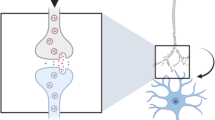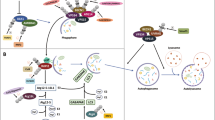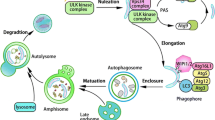Abstract
There are two degradation systems in mammalian cells, autophagy/lysosomal pathway and ubiquitin-proteasome pathway. Proteasome is consist of multiple protein subunits and plays important roles in degradation of short-lived cellular proteins. Recent studies reveal that proteasomal degradation system is also involved in signal transduction and regulation of various cellular functions. Dysfunction or dysregulation of proteasomal function may thus be an important pathogenic mechanism in certain neurological disorders. This paper reviews the biological functions of proteasome in signal transduction and its potential roles in neurodegenerative diseases.
摘要
哺乳动物细胞内有两条蛋白降解途径: 泛素-蛋白酶体通路和自噬-溶酶体通路。蛋白酶体由多种蛋白亚单位组成, 在降解细胞短寿命蛋白中有重要作用。近来的研究发现蛋白酶体降解系统在细胞信号转导和细胞功能中有重要作用。蛋白酶体功能障碍或失调可能参与某些神经退行性疾病的致病机制。本文综述蛋白酶体在细胞信号转导中的生物学功能和在神经退行性疾病中的可能作用。
Similar content being viewed by others
References
Ciechanover A, Orian A, Schwartz AL. Ubiquitin-mediated proteolysis: biological regulation via destruction. Bioessays 2000, 22: 442–451.
Driscoll J, Goldberg AL. The proteasome (multicatalytic protease) is a component of the 1500-kDa proteolytic complex which degrades ubiquitin-conjugated proteins, J Biol Chem 1990, 265: 4789–4792.
Eytan E, Ganoth D, Armon T, Hershko A. ATP-dependent incorporation of 20S protease into the 26S complex that degrades proteins conjugated to ubiquitin, Proc Natl Acad Sci USA 1989, 86: 7751–7755.
Hough R, Pratt G, Rechsteiner M. Purification of two high molecular weight proteases from rabbit reticulocyte lysate. J Biol Chem 1987, 262: 8303–8313.
Zwickl P, Grziwa A, Puhler G, Dahlmann B, Lottspeich F, Baumeister W. Primary structure of the Thermoplasma proteasome and its implications for the structure, function, and evolution of the multicatalytic proteinase. Biochemistry 1992, 31: 964–972.
Zwickl P, Lottspeich F, Dahlmann B, Baumeister W. Cloning and sequencing of the gene encoding the large (alpha-) subunit of the proteasome from Thermoplasma acidophilum. FEBS Lett 1991, 278: 217–221.
Hegerl R, Pfeifer G, Puhler G, Dahlmann B, Baumeister W. The three-dimensional structure of proteasomes from Thermoplasma acidophilum as determined by electron microscopy using random conical tilting. FEBS Lett 1991, 283: 117–121.
Hilt W, Wolf DH. Stress-induced proteolysis in yeast. Mol Microbiol 1992, 6: 2437–2442.
Wenzel T, Baumeister W, Conformational constraints in protein degradation by the 20s proteasome. Nat Struct Biol 1995, 2: 199–204.
Lowe J, Stock D, Jap B, Zwickl P, Baumeister W. Huber R. Crystal structure of the 20S proteasome from the archaeon T. acidophilum at 3.4 A resolution. Science 1995, 268: 533–539.
Groll M, Ditzel L, Lowe J, Stock D, Bochtler M, Bartunik HD, et al. Structure of 20S proteasome from yeast at 2.4 A resolution. Nature 1997, 386: 463–471.
Seemqller E, Lupas A, Stock D, Löwe J, Huber R, Baumeister W. Proteasome from Thermoplasma acidophilum: a threonine protease. Science 1995, 268: 579–582.
Waxman L, Fagan JM, Goldberg AL. Demonstration of two distinct high molecular weight proteases in rabbit reticulocytes, one of which degrades ubiquitin conjugates, J Biol Chem 1987, 262: 2451–2457.
Hough R, Pratt G, Rechsteiner M. Ubiquitin-lysozyme conjugates: Identification and characterization of an ATP-dependent protease from rabbit reticulocyte lysates. J Biol Chem 1986, 261: 2400–2408.
Ciechanover A, The ubiquitin-proteasome pathway: on protein death and cell life. EMBO J 1998, 17: 7151–7160.
Baumeiste W, Walz J, Zuhl F, Seemülle E. The proteasome: paradigm of self compartmentalizing protease. Cell 1998, 92: 367–380.
Hershko A, Ciechanover A. The ubiquitin system. Annu Rev Biochem 1998, 67: 425–479.
Ciechanover A. The ubiquitin-proteasome proteolytic pathway. Cell 1994,79: 13–21.
Glickman MH, Ciechanover A. The ubiquitin-proteasome proteolytic pathway: destruction for the sake of construction. Physiol 2002, 82: 373–428.
Wu JC, Liang ZQ, Qin ZH, Quality Control System of the Endoplasmic Reticulum and Related Diseases. Acta Biochem Biophys Sin 2006, 38: 219–226.
Mizushima N, Noda T, Yoshimori T, Tanaka Y, Ishii T, George MD, et al. A protein conjugation system essential for autophagy. Nature 1998, 395: 395–398.
Hicke L, Riezman H. Ubiquitination of a yeast plasma membrane receptor signals its ligand-stimulated endocytosis. Cell 1996, 84: 277–287.
Katzmann DJ, Babst M, Emr SD. Ubiquitin-dependent sorting into the multivesicular body pathway requires the function of a conserved endosomal protein sorting complex, ESCRT-I. Cell 2001, 106: 145–155.
Ciechanover A. Proteolysis: from the lysosome to ubiquitin and the proteasome. Nat Rev Mol Cell Biol 2005, 6: 79–87.
Myung J, Kim KB, Crews CM. The ubiquitin-proteasome pathway and proteasome inhibitors. Med Res Rev 2001, 21: 245–273.
Qin ZH, Wang Y, Nakai M, Chase TN. Nuclear factor-κB contributes to excitotoxin-induced apoptosis. Mol Pharmacol 1998, 53: 33–42.
Qin ZH, Chen RW, Wang Y, Nakai M, Chuang DM, Chase TN. NF-κB nuclear translocation up-regulates c-Myc and p53 during N-methyl-D-aspartate receptor-mediated apoptosis. J Neurosci 1999, 19: 4023–4033.
Karin M, Ben-Neriah Y. Phosphorylation meets ubiquitination: the control of NFκB activity. Ann Rev Immunol 2000, 18: 621–663.
Stancovski I, Baltimore D. NF-κB activation: the IκB kinase revealed? Cell 1997, 91: 299–302.
Maniatis T. Catalysis by a multiprotein IkappaB kinase complex. Science 1997, 278: 818–819.
Margottin F, Bour SP, Durand H, Selig L, Benichou S, Richard V, et al. A novel human WD protein, h-βTrCp that interacts with HIV-1 Vpu connects CD4 to the ER degradation pathway through an F-box motif. Mol Cell 1998, 1: 565–574.
Yaron A, Hatzubai A, Davis M, Lavon I. Identification of the receptor component of the IκB-ubiquitin ligase. Nature 1998, 396: 590–594.
Jiang J, Struhl G. Regulation of the Hedgehog and Wingless signalling pathways by the F-box/WD40-repeat protein Slimb. Nature 1998, 391: 493–496.
Palombella VJ, Rando OJ, Goldberg AL, Maniatis T. The ubiquitin-proteasome pathway is required for processing the NF-κB1 precursor protein and the activation of NF-κB. Cell 1994, 78: 773–785.
Fan CM, Maniatis T. Generation of p50 subunit of NF-κB by processing of p105 through an ATP-dependent pathway. Nature 1991, 354: 395–398.
Rice NR, MacKichan ML, Israel A. The precursor of NF-κB p50 has IκB-like functions. Cell 1992, 71: 243–253.
Mercurio F, DiDonato JA, Rosette C, Karin M. p105 and p98 precursor proteins play an active role in NF-κB-mediated signal transduction. Genes Dev 1993, 7: 705-718.
Naumann M, Wulczyn FG, Scheidereit C. The NF-κB precursor p105 and the proto-oncogene product Bcl-3 are IκB molecules and control nuclear translocation of NF-κB. EMBO J 1993, 12: 213–222.
Orian A, Gonen H, Bercovich B, Fajerman I, Eytan E, Israel A, et al. SCF(beta)(-TrCP) ubiquitin ligase-mediated processing of NF-κB p105 requires phosphorylation of its C-terminus by IκB kinase. EMBO J 2000, 19: 2580–2591.
Lin L, DeMartino GN, Greene WC. Cotranslational biogenesis of NF-κB p50 by the 26S proteasome. Cell 1998, 92: 819–828.
Spencer E, Jiang J, Chen ZJ. Signal-induced ubiquitination of IκBα by the F-box protein Slimb/β-TrCP. Genes Dev 1999, 13: 284–294.
Jesenberger V, Jentsch S. Deadly encounter: ubiquitin meets apoptosis. Nat Rev Mol Cell Biol 2002, 3: 112–121.
Johnson TR, Stone K, Nikrad M, Yeh T. The proteasome inhibitor PS-341 overcomes TRAIL resistance in Bax and caspase 9-negative or Bcl-xL overexpressing cells. Oncogene 2003, 22: 4953–4963.
Naujokat C, Hoffmann S. Role and function of the 26S proteasome in proliferation and apoptosis. Lab Invest 2002, 82: 965–980.
Breckenridge D, Germain M, Mathai JP, Nguyen M, Shore G. Regulation of apoptosis by endoplasmic reticulum pathways. Oncogene 2003, 22: 8608–8618.
Nakagawa T, Zhu H, Morishima N, Li E, Xu J, Yankner BA, et al. Caspase-12 mediates endoplasmic-reticulum-specific apoptosis and cytotoxicity by amyloid-β. Nature 2000, 403: 98–103.
Oyadomari S, Mori M. Roles of CHOP/GADD153 in endoplasmic reticulum stress. Cell Death Differ 2004, 11: 381–389.
Rao RV, Ellerby HM, Bredesen DE. Coupling endoplasmic reticulum stress to the cell death program. Cell Death Differ 2004, 11: 372–380.
Reinstein E, Ciechanover A. Narrative review: protein degradation and human diseases: the ubiquitin connection. Ann Intern Med 2006, 145: 676–684.
Friedhoff P, von Bergen M, Biernat J, Mandelkow EM, Mandelkow E. Structure of tau protein and assembly into paired helical filaments depends on a local sequence motif ((306) VQIVYK (311)) forming beta structure. Proc Natl Acad Sci USA 2000, 97: 5129–5134.
Geschwind DH. Tau phosphorylation, tangles, and neurodegeneration: the chicken or the egg? Neuron 2003, 40: 457–460.
Johnson GV, Bailey CD. Tau, where are we now? J Alzheimers Dis 2002, 4: 375–398.
Morishima-Kawashima M, Hasegawa M, Takio K, Suzuki M, Yoshida H, Titani K, et al. Proline-directed and non-prolinedirected phosphorylation of PHF-tau. J Biol Chem 1995, 270: 823–829.
David DC, Layfield R, Serpell L, Narain Y, Goedert M, Spillantini MG. Proteasomal degradation of tau protein. J Neurochem 2002, 83: 176–185.
Zhang JY, Liu SJ, Li HL, Wang JZ. Microtubule-associated protein tau is a substrate of ATP/Mg21-dependent proteasome protease system. J Neural Transm 2005, 112: 547–555.
Song S, Kim SY, Hong YM, Jo DG, Lee JY, Shim SM, et al. Essential role of E2-25K/Hip-2 in mediating amyloidbeta neurotoxicity. Mol Cell 2003,12: 553–563.
Zhu X, Raina AK, Lee HG, Casadesus G, Smith MA, Perry G. Oxidative stress signalling in Alzheimer’s disease. Brain Res 2004, 1000: 32–39.
Miranda S, Opazo C, Larrondo LF, Muñoz FJ, Ruiz F, Leighton F, et al. The role of oxidative stress in the toxicity induced by amyloid beta-peptide in Alzheimer’s disease. Prog Neurobiol 2000, 62: 633–648.
Rosen DR. Mutations in Cu/Zn superoxide dismutase gene are associated with familial amyotrophic lateral sclerosis. Nature 1993, 364: 362.
Aquilano K, Rotilio G, Ciriolo MR. Proteasome activation and nNOS down-regulation in neuroblastoma cells expressing a Cu, Zn superoxide dismutase mutant involved in familial ALS. J Neurochem 2003, 85: 1324–1335.
Spillantini MG, Schmidt ML, Lee VM, Trojanowski JQ, Jakes R, Goedert M. Alpha-synuclein in Lewy bodies. Nature 1997, 388: 839–840.
Rubinsztein DC. The roles of intracellular protein-degradation pathways in neurodegeneration. Nature 2006, 443: 780–786.
Paxinou E, Chen Q, Weisse M, Giasson BI, Norris EH, Rueter SM, et al. Induction of alpha-synuclein aggregation by intracellular nitrative insult. J Neurosci 2001, 21: 8053–8061.
Betarbet R, Sherer TB, Greenamyre JT. Ubiquitin-proteasome system and Parkinson’s diseases. Exp Neurol 2005, 191: S17–S27.
Ghee M, Fournier A, Mallet J. Rat α-synuclein interacts with Tat binding protein 1, a component of the 26S proteasomal complex. J Neurochem 2000, 75: 2221–2224.
Chung KK, Zhang Y, Lim KL, Tanaka Y, Huang H, Gao J, et al. Parkin ubiquitinates the alpha-synuclein-interacting protein, synphilin-1 implications for Lewybody formation in Parkinson disease. Nat Med 2001, 7: 1144–1150.
Døskeland AP, Flatmark T. Ubiquitination of soluble and membrane-bound tyrosine hydroxylase and degradation of the soluble form. Eur J Biochem 2002, 269: 1561–1569.
Ciechanover A, Brundin P. The ubiquitin proteasome system in neurodegenerative diseases: sometimes the chicken, sometimes the egg. Neuron 2003, 40: 427–446.
Leroy E, Boyer R, Auburger G, Leube B. The ubiquitin pathway in Parkinson’s disease. Nature 1998, 395: 451–452.
Moore DJ, West AB, Dawson VL, Dawson TM. Molecular pathophysiology of Parkinson’s disease. Ann Rev Neurosci 2005, 28: 57–87.
Liu Y, Fallon L, Lashuel HA, Liu Z, Lansbury PT Jr. The UCHL1 gene encodes two opposing enzymatic activities that affect α-synuclein degradation and Parkinson’s disease susceptibility. Cell 2002, 111: 209–218.
Saigoh K, Wang YL, Suh JG, Yamanishi T. Intragenic deletion in the gene encoding ubiquitin carboxy-terminal hydrolase in gad mice. Nat Genet 1999, 23: 47–51.
Holmberg CI, Staniszewski KE, Mensah KN, Matouschek A, Morimoto RI. Inefficient degradation of truncated polyglutamine proteins by the proteasome. EMBO J 2004, 23: 4307–4318.
Perutz MF, Johnson T, Suzuki M, Finch JT. Glutamine repeats as polar zippers: their possible role in inherited neurodegenerative diseases. Proc Natl Acad Sci USA 1994, 91: 5355–5358.
Perutz MF. Polar zippers: their role in human disease. Pharm Acta Helv 1995, 69: 213–224.
Stott K, Blackburn JM, Butler PJ, Perutz M. Incorporation of glutamine repeats makes protein oligomerize: implications for neurodegenerative diseases. Proc Natl Acad Sci USA 1995, 92: 6509–6513.
Arribas J, Castano JG. Kinetic studies of the differential effect of detergents on the peptidase activities of the multicatalytic proteinase from rat liver. J Biol Chem 1990, 265: 13969–13973.
Djaballah H, Rivett AJ. Peptidylglutamyl-peptide hydrolase activity of the multicatalytic proteinase complex: evidence for a new high-affinity site, analysis of cooperative kinetics, and the effect of manganese ions. Biochemistry 1992, 31: 4133–4141.
Kisselev AF, Garcia-Calvo M, Overkleeft HS, Peterson E, Pennington MW, Ploegh HL, et al. The caspaselike sites of proteasomes, their substrate specificity, new inhibitors and substrates, and allosteric interactions with the trypsin-like sites. J Biol Chem 2003, 278: 35869–35877.
Hunter JM, Lesort M, Johnson GV. Ubiquitin-proteasome system alterations in a striatal cell model of Huntington’s disease. J Neurosci Res 2007, 85: 1774–1788.
Bence NF, Sampat RM, Kopito RR. Impairment of the ubiquitin-proteasome system by protein aggregation. Science 2001, 292: 1552–1555.
Jana NR, Zemskov EA, Wang G, Nukina N. Altered proteasomal function due to the expression of polyglutamine-expanded truncated N-terminal huntingtin induces apoptosis by caspase activation through mitochondrial cytochrome c release. Hum Mol Genet 2001, 10: 1049–1059.
Sieradzan KA, Mechan AO, Jones L, Wanker EE, Nukina N, Mann DM. Huntington’s disease intranuclear inclusions contain truncated, ubiquitinated huntingtin protein. Exp Neurol 1999, 156: 92–99.
Davies SW, Turmaine M, Cozens BA, DiFiglia M, Sharp AH, Ross CA, et al. Formation of neuronal intranuclear inclusions underlies the neurological dysfunction in mice transgenic for the HD mutation. Cell 1997, 90: 537–548.
Saudou F, Finkbeiner S, Devys D, Greenberg ME. Huntingtin acts in the nucleus to induce apoptosis but death does not correlate with the formation of intranuclear inclusions. Cell 1998, 95: 55–66.
Michalik A, Van Broeckhoven C. Proteasome degrades soluble expanded polyglutamine completely and efficiently. Neurobiol Dis 2004, 16: 202–211.
Bett JS, Goellner GM, Woodman B, Pratt G, Rechsteiner M, Bates GP. Proteasome impairment does not contribute to pathogenesis in R6/2 Huntington’s disease mice: exclusion of proteasome activator REGgamma as a therapeutic target. Hum Mol Genet 2006, 15: 33–44.
Díaz-Hernández M, Hernández F, Martín-Aparicio E, Gómez-Ramos P, Morán MA, Castaño JG, et al. Neuronal induction of the immunoproteasome in Huntington’s disease. J Neurosci 2003, 23: 11653–11661.
Díaz-Hernández M, Martín-Aparicio E, Avila J, Hernández F, Lucas JJ. Enhanced induction of the immunoproteasome by interferon gamma in neurons expressing mutant Huntingtin. Neurotox Res 2004, 6: 463–468.
Author information
Authors and Affiliations
Corresponding author
Rights and permissions
About this article
Cite this article
Chen, JJ., Lin, F. & Qin, ZH. The roles of the proteasome pathway in signal transduction and neurodegenerative diseases. Neurosci. Bull. 24, 183–194 (2008). https://doi.org/10.1007/s12264-008-0183-6
Received:
Published:
Issue Date:
DOI: https://doi.org/10.1007/s12264-008-0183-6




